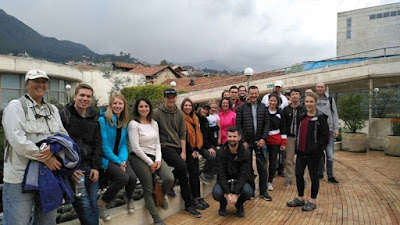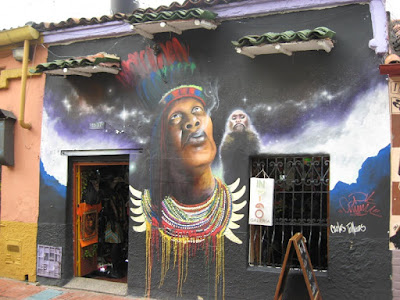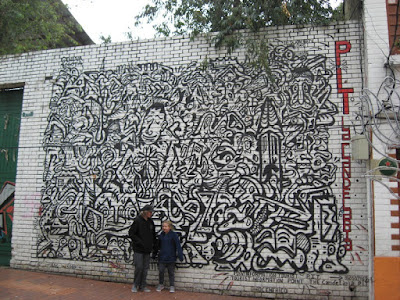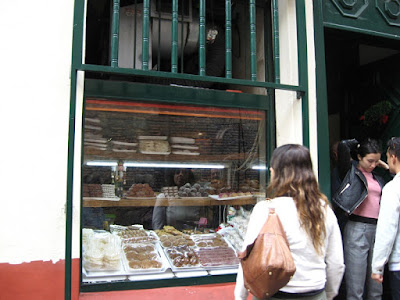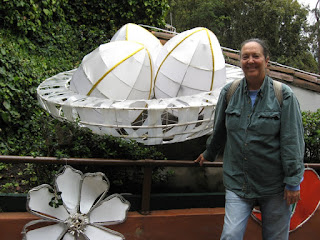One major street (Calle 7) has been turned into a pedestrian mall walkway near us. It is a safe walking zone from our hotel all the way to the tourist spots beyond the main center--very nice, but you still have to watch your step. Here, a street performer seems to levitate above the ground.
Men play chess along the sidewalks. I never considered chess a spectator sport, but they draw quite a crowd, all men.
This man is dressed as an Native American. Busking is popular on this mall.
A silver mime standing perfectly still. We later saw two of the silver men performing and singing.
A huge press in the money museum. Photos weren't allowed inside.
Our walking tour met in front of the Gold Museum.
This young man was doing acrobatics on his bicycle in the plaza.
Karen and Jason at Casa Galeria, a cute, Bohemian-style coffee shop where our tour group stopped to try 'chicha', a fermented corn drink that is popular, but not allowed to be bottled or sold commercially. Some say it is similar to beer, but I bought a bottle a few days later from an old man along the sidewalk and it reminded me more of a hard cinnamon-apple cider. Tasty.
The purple and yellow of Casa Galeria on Funnel Lane. The neighborhood reminds me of a hippy hangout.
A tiny gourd of chicha to taste. We got to keep the little cups as souvenirs.
Jason about to down his chicha.
Each of the little gourd cups was hand carved.Coca tea, chicha and chucula were available, as was some great Colombian coffee. Usually, they export the good stuff, so getting great coffee here requires some local knowledge.
Coca tea here isn't illegal. It's medicinal and they say you won't get high from it. I remember as a child, we'd take coke syrup as medicine. The prescription came in a brown glass bottle.
'Chucula' is a drink made from seven grains and seeds (corn, beans, chickpeas, cocoa beans, lentils, barley and wheat), with some cinnamon and cloves and cane sugar. The grains are ground up, mixed and boiled with the cane sugar, and rolled into these brown balls. Then you put one brown ball into a cup and pour hot milk over it, smashing and stirring the sweet brown ball into it. Delicious! Like a spiced hot chocolate.
The 3-D mural across the lane from Cafe Galeria.
The 3-D panorama mural even put the artist's email in 3-d along the bottom.
A nice collection of glass in the Cafe Galeria.
Jason and another tourist yakking by the sunshine painting in Cafe Galeria.
The modern espresso machine hurried the making of chucula, steaming the milk quickly for the tasty drink.
The area known as La Candelaria is known for its graffiti art. We saw some along our tour.
The graffiti artists apply for a permit and a space to paint, so it becomes art versus an eyesore. This is looking back down Funnel Alley.
More art on the street.
The white trees here are plastic.
A very old building on the plaza at the top of Funnel Alley. Some say this is the place where Bogota was first founded, but nobody really knows. All old records were burned in a fire long ago.
An old, little church on the same plaza.
A juggler metal sculpture on top of a house in that plaza on Funnel Alley.
The locals claim this is the oldest house in Bogota. It is why they claim it was the founding point for the city.
Heading down one of the cobblestone streets of La Candelaria in Bogota, on our walking tour.
I saw a couple of variations on the Coca Cola logo. This one is for chicha, the fermented corn drink.
This set of doors reminds me of a face. It also has the door within a door, which is common around here in the old buildings.
This painting looks like is belongs on a head shop, for sure.
The entire wall of this university building is tile artwork.
This is a popular graffiti wall of art that many tourists get their photos taken in front of.
A nifty door knocker.
A blue and white tile mural reminded us of the churches in Brazil.
This used to be the mansion where Simon Bolivar lived until a group tried to break in and kill him.
He escaped naked out this window and hid for a day under bridges and such.
A nice statue in a park across from Bolivar's mansion.
Government buildings are in the old brick and sandstone structures around the main plaza here in Bogota.
Some impressive old churches and cathedrals also line the plaza square.
The old Catholic services used to be in Latin and last for many hours. The locals speak Spanish and didn't understand a word of the service, so were bored silly. The men used to sneak out the side door shown here and head across the lane for a drink. Then they could return vial the same false portal and snooze through the rest of the sermons.
More impressive door knockers.
The False Door, La Puerta Falsa in Spanish, was the favorite destination for the escaping church-goers. It has remained in the same family for seven generations and is now a tourist spot with a line always out the door.
They sell a wide variety of sweets to tempt us in.
More huge walls of color.
A typical soup for a meal here. It is usually served with rice and a huge chunk of avocado to put in it, too. Good hearty meal.
Some unusual statues on a corner near our hotel. No clue as to what they represent or who the artist was.
Chaney, Bogota style. A bunch of broken bricks and pottery tiles fill in some of the broken out sidewalk.
There is very little green space in this city of nearly 10 million people, so this cafe grows its lettuce on the wall outside its doors. Clever.
We took the funicular up to Montserrate, a church on top of the highest mountain around Bogota. Here we have just left the terminal.
The vista from the top and the rides up and down are spectacular.The funicular car.
Coming to the tunnel at the top.
The car heading back down.
At the top, there were tons of decorations for Christmas and Easter. They are made of thin nylon material. I presume this basket of eggs is an early Easter decoration.
Jason as an angel.
Karen fits the angel better.
Some pretty flowers hanging on the trees at the top, over 8300' high. Easy to get winded walking up here.
A wishing well.
We were often at or above the clouds here at Montserrate.
Jason looking in at the church service going on. He carried his laptop with him in the backpack as we were told it wasn't secure to leave it at the hotel. Jason goes 'camo'.
A view looking down at Bogota.
Tamales steaming in a huge pot at a restaurant is not uncommon.
Open grills are everywhere. Corn, hotdogs, stuffed plantains, and more on offer.
More pretty flowers up on top.
Another view from Montserrate. Our hotel is about in the dead center of this shot.
The old brickwork and the crenelated tower
Bags of treats for sale all along the walkways.
Jason and a big cow statue along the boulevard.
This old truck in town caught our eye.
Walking along a street near our hotel. The man and his handcart was seen often.
This old man had his own handcart full of old cardboard and scrap wood. He was along the main pedestrian walkway through the city.
Jason on our walking tour, passing another graffiti wall art.
Our tour gave us a coupon for a free uncut emerald at a particular shop, along with a free 'workshop'. The workshop was really just a salesperson explaining the basics of emeralds and how they are valued and their different types. This one was showing us a 'trapiche', a particular form of emerald that looks like a wheel. It is formed from cylinders of crystals growing together. When it is sliced it looks like a wheel or flower The sales girl put the example over the light on her phone so it would shine through to show the design. Very different form of emerald, and pretty rare. Good ones are very expensive.Out in the plaza near this emerald shop, men hang around all day, every day, with cut and uncut emeralds to sell on the black market. They carry thousands of dollars worth of stones in their pockets and would be happy to sell them to you. I don't speak enough Spanish to carry on a negotiation about price and quality. Since you have no retail operation to back these stones, you could be buying fake or treated stones and have no recourse. One man had a handful of light green, almost aquamarine crystals he wanted to sell me. The photo is blurry, but you can see they aren't the normal dark green you'd expect. Still they were pretty. I just couldn't understand how much he wanted for them. He didn't seem able to write, so we just gave up and left. We'd been swarmed by sellers once we showed an interest and Jason started to get annoyed.
The entrance to the National Museum. The bricks have hints of colors in them that made them very pretty.
A huge, colorful painting of tropical birds on the side of a tall building.
Jason with a tamal (we'd call it a tamale) for breakfast at our hotel. They aren't quite the same as Mexican tamales, but it's the same principal: steamed corn and rice with veges and some meat.
The mush inside was actually very good tasting. The banana or plantain leaves were layered and tied to steam the insides.
The second-tallest building in the country was in our view from the hotel.
The International Emerald Museum didn't allow photos inside their mine representation or their gallery, but provided a spot for photos that would be like the vein in a mine. Here I am posed with a hammer and a chunk of rock near a vein of emeralds in the wall.
They gave us cookies with their emblem on them. Here it is in the vein provided for photos.
A bit blurry, but this is what a vein of emeralds would look like in a mine. The cloudy ones, called mujarrah, used to be thrown out or used as doorstops. Only the clear green crystals were kept and sold for jewelry. Now, they've realized that both forms have value and you see lots of carvings and jewelry with the cloudy ones and the matrix of rock incorporated into the carvings.
A typical mine cart used to carry the emerald-bearing rock out of the mines.
A big display of butterflies outside the showroom in the emerald museum.
The Emerald Museum is in the 23rd floor of the Avianca airlines building. An unusual place to build a replica of the mines, but they also get a great view of the city and plaza below. They let us take photos out the windows but wouldn't allow photos of their gems and jewelry.
